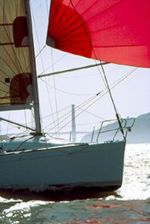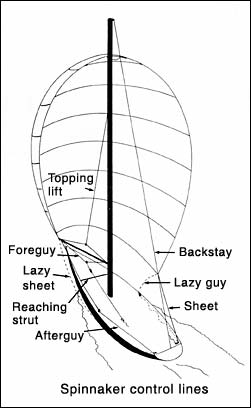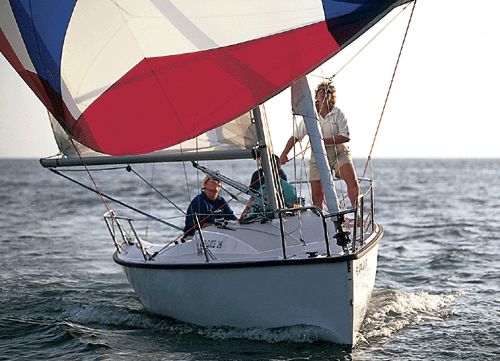The Spinnaker - When to Fly It
Part 2 of the Spinnaker Series
 The first big spinnaker decision is whether or not to fly. Is the crew experienced enough? Is the wind too heavy or too light? Is the wind to far forward?
The first big spinnaker decision is whether or not to fly. Is the crew experienced enough? Is the wind too heavy or too light? Is the wind to far forward?
The wind strength and direction weigh heavily on the choice of "chute" as described above. Once, in a 5.5-meter boat, I set a running chute in light air with the wind well aft, only to find that the increased boat speed brought the apparent wind so far forward that a reaching chute was called for. Shortly thereafter, on rounding the weather mark and anticipating the same true-wind angle, but in a heavy breeze, I set a reaching spinnaker only to find that the increased boat speed failed to bring the apparent wind forward. That day we should have set the running spinnaker. On a larger boat, the navigator would have calculated the anticipated strength and angle of the new apparent wind, and the proper chute for the conditions would have been selected.
On a light-to-medium day, some spinnakers can be carried to advantage when the apparent wind is well forward (as close as 55 to 60 degrees relative from the bow), but they could cause a broach and a bad weather helm at the same apparent wind angle in heavier air. Learning to read wind conditions relative to the spinnaker comes with practice; it's part of the challenge.
Another factor in your decision to set or not is the relative sail areas of spinnaker and jib. On a boat with a large jib, if the wind is too far forward or heavy enough to cause a broach, you may find the boat will go faster under the jib. On other boats, the spinnaker has so much more area than the jib, so even if you are broaching you will probably net out with a faster speed through the water with the spinnaker than without. When racing, go by the old axiom, "If in doubt, set."
On very heavy days it almost always pays to carry a spinnaker if you're racing. I've often heard the argument on large racing boats that if the boat is already at hull speed, setting a spinnaker won't improve it. That's a fallacy. When sailing in a trough of a wave and up the other side, the boat is rarely going near hull speed, and needs the extra power that a spinnaker provides. Furthermore, under surfing conditions there is no such thing as hull speed; all sailboats can surpass it. The spinnaker will give more power to start the surf earlier and make it last longer.
Always remember the importance of the apparent wind angle. I've often heard the argument when we're beam-reaching with an 85 percent flat spinnaker that we'd go faster with a full-sized spinnaker because the breeze had died a little. Experience dictates that the full-sized spinnaker increases weather helm for the reasons mentioned earlier. The increased rudder drag often offsets the greater size of the spinnaker.
On very light days a chute will fill well if the spinnaker cloth is light enough and the apparent wind relatively far forward. But with the wind way aft, particularly with leftover slop rolling the boat around, a jib may do just as well. The spinnaker will just flop back and forth, wrapping around the jibstay and catching on the spreaders. You're usually better off without it in such conditions.
...Finally, check to be sure that the halyard leads correctly and is clear all the way up. You are now ready for the hoist, and the spinnaker should come out of the bag without a twist.
Reprinted from "Steve Colgate on Sailing."
By Steve Colgate, Published by W.W. Norton & Co.
Steve Colgate is the founder of Colgate Sailing Schools, with locations in Tortola BVI, Captiva Island FL, Duck Key FL, St. Petersburg FL, Chelsea Piers NY, Liberty Landing NJU and Newport RI.
Offshore Sailing Schools
16731 McGregor Blvd.
Fort Myers, Florida 33908
1-888-454-8002
239-454-1700
Fax: 239-454-1191
e-mail: [email protected]
www.offshoresailing.com












